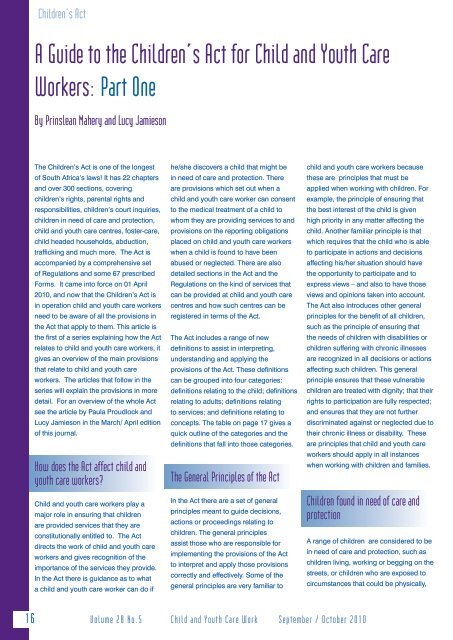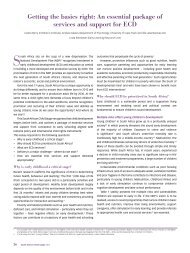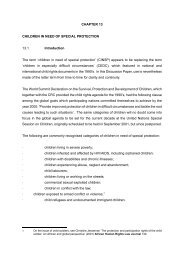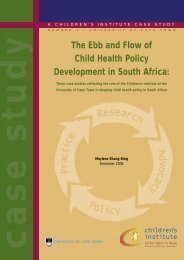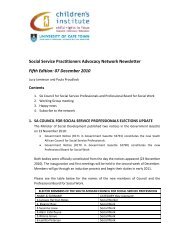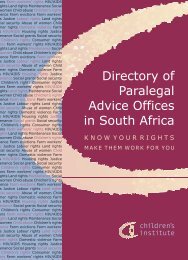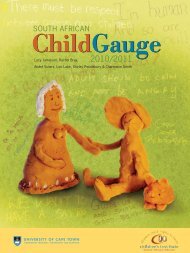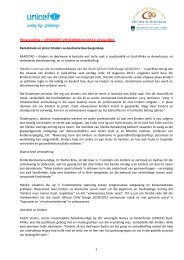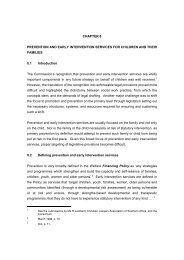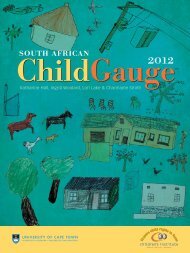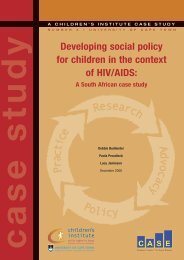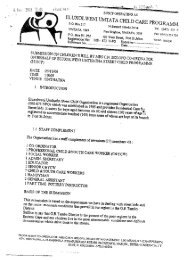A guide to the Children's Act for child and youth care workers: Part one
A guide to the Children's Act for child and youth care workers: Part one
A guide to the Children's Act for child and youth care workers: Part one
- No tags were found...
You also want an ePaper? Increase the reach of your titles
YUMPU automatically turns print PDFs into web optimized ePapers that Google loves.
Children’s <strong>Act</strong><br />
A Guide <strong>to</strong> <strong>the</strong> Children’s <strong>Act</strong> <strong>for</strong> Child <strong>and</strong> Youth Care<br />
Workers: <strong>Part</strong> One<br />
By Prinslean Mahery <strong>and</strong> Lucy Jamieson<br />
The Children’s <strong>Act</strong> is <strong>one</strong> of <strong>the</strong> longest<br />
of South Africa’s laws! It has 22 chapters<br />
<strong>and</strong> over 300 sections, covering<br />
<strong>child</strong>ren’s rights, parental rights <strong>and</strong><br />
responsibilities, <strong>child</strong>ren’s court inquiries,<br />
<strong>child</strong>ren in need of <strong>care</strong> <strong>and</strong> protection,<br />
<strong>child</strong> <strong>and</strong> <strong>youth</strong> <strong>care</strong> centres, foster-<strong>care</strong>,<br />
<strong>child</strong> headed households, abduction,<br />
trafficking <strong>and</strong> much more. The <strong>Act</strong> is<br />
accompanied by a comprehensive set<br />
of Regulations <strong>and</strong> some 67 prescribed<br />
Forms. It came in<strong>to</strong> <strong>for</strong>ce on 01 April<br />
2010, <strong>and</strong> now that <strong>the</strong> Children’s <strong>Act</strong> is<br />
in operation <strong>child</strong> <strong>and</strong> <strong>youth</strong> <strong>care</strong> <strong>workers</strong><br />
need <strong>to</strong> be aware of all <strong>the</strong> provisions in<br />
<strong>the</strong> <strong>Act</strong> that apply <strong>to</strong> <strong>the</strong>m. This article is<br />
<strong>the</strong> first of a series explaining how <strong>the</strong> <strong>Act</strong><br />
relates <strong>to</strong> <strong>child</strong> <strong>and</strong> <strong>youth</strong> <strong>care</strong> <strong>workers</strong>, it<br />
gives an overview of <strong>the</strong> main provisions<br />
that relate <strong>to</strong> <strong>child</strong> <strong>and</strong> <strong>youth</strong> <strong>care</strong><br />
<strong>workers</strong>. The articles that follow in <strong>the</strong><br />
series will explain <strong>the</strong> provisions in more<br />
detail. For an overview of <strong>the</strong> whole <strong>Act</strong><br />
see <strong>the</strong> article by Paula Proudlock <strong>and</strong><br />
Lucy Jamieson in <strong>the</strong> March/ April edition<br />
of this journal.<br />
How does <strong>the</strong> <strong>Act</strong> affect <strong>child</strong> <strong>and</strong><br />
<strong>youth</strong> <strong>care</strong> <strong>workers</strong><br />
Child <strong>and</strong> <strong>youth</strong> <strong>care</strong> <strong>workers</strong> play a<br />
major role in ensuring that <strong>child</strong>ren<br />
are provided services that <strong>the</strong>y are<br />
constitutionally entitled <strong>to</strong>. The <strong>Act</strong><br />
directs <strong>the</strong> work of <strong>child</strong> <strong>and</strong> <strong>youth</strong> <strong>care</strong><br />
<strong>workers</strong> <strong>and</strong> gives recognition of <strong>the</strong><br />
importance of <strong>the</strong> services <strong>the</strong>y provide.<br />
In <strong>the</strong> <strong>Act</strong> <strong>the</strong>re is guidance as <strong>to</strong> what<br />
a <strong>child</strong> <strong>and</strong> <strong>youth</strong> <strong>care</strong> worker can do if<br />
he/she discovers a <strong>child</strong> that might be<br />
in need of <strong>care</strong> <strong>and</strong> protection. There<br />
are provisions which set out when a<br />
<strong>child</strong> <strong>and</strong> <strong>youth</strong> <strong>care</strong> worker can consent<br />
<strong>to</strong> <strong>the</strong> medical treatment of a <strong>child</strong> <strong>to</strong><br />
whom <strong>the</strong>y are providing services <strong>to</strong> <strong>and</strong><br />
provisions on <strong>the</strong> reporting obligations<br />
placed on <strong>child</strong> <strong>and</strong> <strong>youth</strong> <strong>care</strong> <strong>workers</strong><br />
when a <strong>child</strong> is found <strong>to</strong> have been<br />
abused or neglected. There are also<br />
detailed sections in <strong>the</strong> <strong>Act</strong> <strong>and</strong> <strong>the</strong><br />
Regulations on <strong>the</strong> kind of services that<br />
can be provided at <strong>child</strong> <strong>and</strong> <strong>youth</strong> <strong>care</strong><br />
centres <strong>and</strong> how such centres can be<br />
registered in terms of <strong>the</strong> <strong>Act</strong>.<br />
The <strong>Act</strong> includes a range of new<br />
definitions <strong>to</strong> assist in interpreting,<br />
underst<strong>and</strong>ing <strong>and</strong> applying <strong>the</strong><br />
provisions of <strong>the</strong> <strong>Act</strong>. These definitions<br />
can be grouped in<strong>to</strong> four categories:<br />
definitions relating <strong>to</strong> <strong>the</strong> <strong>child</strong>; definitions<br />
relating <strong>to</strong> adults; definitions relating<br />
<strong>to</strong> services; <strong>and</strong> definitions relating <strong>to</strong><br />
concepts. The table on page 17 gives a<br />
quick outline of <strong>the</strong> categories <strong>and</strong> <strong>the</strong><br />
definitions that fall in<strong>to</strong> those categories.<br />
The General Principles of <strong>the</strong> <strong>Act</strong><br />
In <strong>the</strong> <strong>Act</strong> <strong>the</strong>re are a set of general<br />
principles meant <strong>to</strong> <strong>guide</strong> decisions,<br />
actions or proceedings relating <strong>to</strong><br />
<strong>child</strong>ren. The general principles<br />
assist those who are responsible <strong>for</strong><br />
implementing <strong>the</strong> provisions of <strong>the</strong> <strong>Act</strong><br />
<strong>to</strong> interpret <strong>and</strong> apply those provisions<br />
correctly <strong>and</strong> effectively. Some of <strong>the</strong><br />
general principles are very familiar <strong>to</strong><br />
<strong>child</strong> <strong>and</strong> <strong>youth</strong> <strong>care</strong> <strong>workers</strong> because<br />
<strong>the</strong>se are principles that must be<br />
applied when working with <strong>child</strong>ren. For<br />
example, <strong>the</strong> principle of ensuring that<br />
<strong>the</strong> best interest of <strong>the</strong> <strong>child</strong> is given<br />
high priority in any matter affecting <strong>the</strong><br />
<strong>child</strong>. Ano<strong>the</strong>r familiar principle is that<br />
which requires that <strong>the</strong> <strong>child</strong> who is able<br />
<strong>to</strong> participate in actions <strong>and</strong> decisions<br />
affecting his/her situation should have<br />
<strong>the</strong> opportunity <strong>to</strong> participate <strong>and</strong> <strong>to</strong><br />
express views – <strong>and</strong> also <strong>to</strong> have those<br />
views <strong>and</strong> opinions taken in<strong>to</strong> account.<br />
The <strong>Act</strong> also introduces o<strong>the</strong>r general<br />
principles <strong>for</strong> <strong>the</strong> benefit of all <strong>child</strong>ren,<br />
such as <strong>the</strong> principle of ensuring that<br />
<strong>the</strong> needs of <strong>child</strong>ren with disabilities or<br />
<strong>child</strong>ren suffering with chronic illnesses<br />
are recognized in all decisions or actions<br />
affecting such <strong>child</strong>ren. This general<br />
principle ensures that <strong>the</strong>se vulnerable<br />
<strong>child</strong>ren are treated with dignity; that <strong>the</strong>ir<br />
rights <strong>to</strong> participation are fully respected;<br />
<strong>and</strong> ensures that <strong>the</strong>y are not fur<strong>the</strong>r<br />
discriminated against or neglected due <strong>to</strong><br />
<strong>the</strong>ir chronic illness or disability. These<br />
are principles that <strong>child</strong> <strong>and</strong> <strong>youth</strong> <strong>care</strong><br />
<strong>workers</strong> should apply in all instances<br />
when working with <strong>child</strong>ren <strong>and</strong> families.<br />
Children found in need of <strong>care</strong> <strong>and</strong><br />
protection<br />
A range of <strong>child</strong>ren are considered <strong>to</strong> be<br />
in need of <strong>care</strong> <strong>and</strong> protection, such as<br />
<strong>child</strong>ren living, working or begging on <strong>the</strong><br />
streets, or <strong>child</strong>ren who are exposed <strong>to</strong><br />
circumstances that could be physically,<br />
m<br />
c<br />
a<br />
n<br />
in<br />
w<br />
li<br />
in<br />
a<br />
a<br />
c<br />
c<br />
s<br />
is<br />
c<br />
c<br />
w<br />
c<br />
o<br />
p<br />
w<br />
c<br />
c<br />
a<br />
c<br />
w<br />
C<br />
A<br />
c<br />
r<br />
o<br />
a<br />
p<br />
in<br />
h<br />
c<br />
r<br />
a<br />
p<br />
s<br />
y<br />
a<br />
m<br />
s<br />
b<br />
d<br />
c<br />
d<br />
a<br />
16 Volume 28 No.5 Child <strong>and</strong> Youth Care Work September / Oc<strong>to</strong>ber 2010
Children’s <strong>Act</strong><br />
mentally or socially harmful <strong>to</strong> <strong>the</strong>m. A<br />
<strong>child</strong> in a <strong>child</strong> headed household is not<br />
au<strong>to</strong>matically considered <strong>to</strong> be a <strong>child</strong> in<br />
need of <strong>care</strong> <strong>and</strong> protection <strong>and</strong> fur<strong>the</strong>r<br />
investigations from a designated social<br />
worker must determine whe<strong>the</strong>r <strong>child</strong>ren<br />
living in such circumstances are <strong>child</strong>ren<br />
in need of <strong>care</strong> <strong>and</strong> protection. When<br />
a <strong>child</strong> <strong>and</strong> <strong>youth</strong> <strong>care</strong> worker comes<br />
across a <strong>child</strong> considered in need of<br />
<strong>care</strong> <strong>and</strong> protection in <strong>the</strong> <strong>Act</strong> he/she<br />
cannot remove that <strong>child</strong> <strong>to</strong> a place of<br />
safety without a court order. If <strong>the</strong> matter<br />
is brought <strong>to</strong> <strong>the</strong> attention of a <strong>child</strong>ren’s<br />
court commissi<strong>one</strong>r <strong>the</strong> commissi<strong>one</strong>r<br />
could authorize <strong>the</strong> <strong>child</strong> <strong>and</strong> <strong>youth</strong> <strong>care</strong><br />
worker <strong>to</strong> remove <strong>the</strong> <strong>child</strong> through a<br />
court order. According <strong>to</strong> <strong>the</strong> <strong>Act</strong> it is<br />
only a designated social worker or a<br />
police official that can remove a <strong>child</strong><br />
without a court order in emergency<br />
cases. The detailed procedures involving<br />
<strong>child</strong>ren in need of <strong>care</strong> <strong>and</strong> protection<br />
<strong>and</strong> <strong>the</strong> orders that a <strong>child</strong>ren’s court<br />
can make involving <strong>child</strong> <strong>and</strong> <strong>youth</strong> <strong>care</strong><br />
<strong>workers</strong> are set out in <strong>the</strong> <strong>Act</strong>.<br />
Child <strong>and</strong> <strong>youth</strong> <strong>care</strong> centres<br />
According <strong>to</strong> <strong>the</strong> <strong>Act</strong> a <strong>child</strong> <strong>and</strong> <strong>youth</strong><br />
<strong>care</strong> centre is a facility that provides<br />
residential <strong>care</strong> <strong>for</strong> more than six <strong>child</strong>ren<br />
outside <strong>the</strong> <strong>child</strong>’s family environment<br />
<strong>and</strong> in accordance with a residential<br />
programme suitable <strong>for</strong> <strong>the</strong> <strong>child</strong>ren<br />
in <strong>the</strong> facility. Government <strong>child</strong>ren’s<br />
homes, places of safety, secure<br />
<strong>care</strong> facilities, schools of industry or<br />
re<strong>for</strong>ma<strong>to</strong>ry schools are all now regarded<br />
as <strong>child</strong> <strong>and</strong> <strong>youth</strong> <strong>care</strong> centres <strong>and</strong><br />
privately registered <strong>child</strong>ren’s homes <strong>and</strong><br />
shelters are also now called <strong>child</strong> <strong>and</strong><br />
<strong>youth</strong> <strong>care</strong> centres. To register a <strong>child</strong><br />
<strong>and</strong> <strong>youth</strong> <strong>care</strong> centre an application<br />
must be made <strong>to</strong> <strong>the</strong> provincial head of<br />
social development on a <strong>for</strong>m required<br />
by <strong>the</strong> <strong>Act</strong>. The provincial head of social<br />
development <strong>the</strong>n has six months <strong>to</strong><br />
consider <strong>the</strong> application <strong>and</strong> make a<br />
decision about accepting or rejecting <strong>the</strong><br />
application.<br />
Category<br />
Definitions relating <strong>to</strong> a<br />
<strong>child</strong><br />
Definitions relating <strong>to</strong><br />
adults<br />
Definitions relating <strong>to</strong><br />
services<br />
Definitions relating <strong>to</strong><br />
concepts<br />
One of <strong>the</strong> fac<strong>to</strong>rs taken in<strong>to</strong> account<br />
when an application is made <strong>to</strong> register<br />
or renew registration of a <strong>child</strong> <strong>and</strong> <strong>youth</strong><br />
<strong>care</strong> centre is whe<strong>the</strong>r <strong>the</strong> applicant is a<br />
fit <strong>and</strong> proper person. This requirement<br />
of being fit <strong>and</strong> proper person comes out<br />
in many provisions of <strong>the</strong> <strong>Act</strong>. All staff<br />
managing, assisting or volunteering at<br />
a <strong>child</strong> <strong>and</strong> <strong>youth</strong> <strong>care</strong> centre must be<br />
considered fit <strong>and</strong> proper persons. While<br />
<strong>the</strong>re is no definition of a ‘fit <strong>and</strong> proper<br />
person’ <strong>the</strong> <strong>Act</strong> is clear that a person is<br />
not considered <strong>to</strong> be a ‘fit <strong>and</strong> proper’<br />
person if his/her name appears on part B<br />
of <strong>the</strong> National Child Protection Register.<br />
Alternative <strong>care</strong><br />
The chapters on <strong>child</strong> <strong>and</strong> <strong>youth</strong> <strong>care</strong><br />
centres <strong>and</strong> alternative <strong>care</strong> in <strong>the</strong><br />
<strong>Act</strong> must be read <strong>to</strong>ge<strong>the</strong>r <strong>to</strong> obtain<br />
a broader underst<strong>and</strong>ing of <strong>the</strong> rules<br />
regarding <strong>child</strong> <strong>and</strong> <strong>youth</strong> <strong>care</strong> centres<br />
<strong>and</strong> <strong>the</strong> <strong>child</strong>ren who receive services<br />
What is defined<br />
at those centres. If a court has made an<br />
order that a <strong>child</strong> should be placed in a<br />
<strong>child</strong> <strong>and</strong> <strong>youth</strong> <strong>care</strong> centre, that <strong>child</strong><br />
is regarded as being in alternative <strong>care</strong><br />
Table<br />
• A <strong>child</strong> headed household<br />
• A street <strong>child</strong><br />
• A <strong>child</strong> in need of <strong>care</strong> <strong>and</strong> protection<br />
• A <strong>care</strong>-giver<br />
• A social service professional<br />
• A designated social worker<br />
• Temporary safe <strong>care</strong><br />
• Secure Care<br />
• Cluster foster <strong>care</strong><br />
• Cluster foster <strong>care</strong> scheme<br />
• Designated <strong>child</strong> protection • services<br />
• Designated <strong>child</strong> protection organisation<br />
• Men<strong>to</strong>ring scheme <strong>for</strong> <strong>child</strong> headed household<br />
• Prevention <strong>and</strong> early intervention programmes<br />
• A <strong>child</strong> <strong>and</strong> <strong>youth</strong> <strong>care</strong> centre<br />
• A drop-in centre<br />
• The terms ‘<strong>care</strong>’ <strong>and</strong> ‘contact’<br />
• The concept of parental responsibilities <strong>and</strong> rights<br />
• The terms ‘abuse’; ‘sexual abuse’ <strong>and</strong> ‘neglect’<br />
<strong>and</strong> strict rules apply as <strong>to</strong> when that<br />
<strong>child</strong> can take a leave of absence away<br />
from <strong>the</strong> centre, what happens when<br />
<strong>the</strong> <strong>child</strong> absconds from <strong>the</strong> centre <strong>and</strong><br />
when such a <strong>child</strong> can be discharged<br />
from alternative <strong>care</strong>. Thus <strong>the</strong>re is a<br />
difference between <strong>child</strong>ren who attend<br />
a <strong>child</strong> <strong>and</strong> <strong>youth</strong> <strong>care</strong> centre voluntarily<br />
or because <strong>the</strong>y are referred <strong>to</strong> <strong>the</strong><br />
centre by a parent or <strong>care</strong>giver <strong>to</strong> receive<br />
services <strong>and</strong> a <strong>child</strong> that has been placed<br />
at <strong>the</strong> centre through a court order.<br />
The role of <strong>the</strong> <strong>child</strong> <strong>and</strong> <strong>youth</strong><br />
<strong>care</strong> worker regarding <strong>the</strong> health of<br />
<strong>child</strong>ren:<br />
As <strong>care</strong>givers<br />
One of <strong>the</strong> new definitions in <strong>the</strong> <strong>Act</strong> is<br />
that of ‘<strong>care</strong>-giver’. The <strong>Act</strong> says that<br />
a <strong>care</strong>-giver is any<strong>one</strong> o<strong>the</strong>r than a<br />
parent or guardian who factually <strong>care</strong>s<br />
<strong>for</strong> a <strong>child</strong> <strong>and</strong> includes <strong>the</strong> head of<br />
a <strong>child</strong> <strong>and</strong> <strong>youth</strong> <strong>care</strong> centre where<br />
<strong>the</strong> <strong>child</strong> was placed, or a <strong>child</strong> <strong>and</strong><br />
<strong>youth</strong> <strong>care</strong> worker supporting <strong>child</strong>ren<br />
without <strong>care</strong> in <strong>the</strong> community. One of<br />
September / Oc<strong>to</strong>ber 2010 Child <strong>and</strong> Youth Care Work Volume 28 No.5 17
Children’s <strong>Act</strong><br />
<strong>the</strong> responsibilities that a <strong>care</strong>-giver has<br />
relates <strong>to</strong> consenting <strong>to</strong> <strong>the</strong> medical<br />
treatment of <strong>the</strong> <strong>child</strong>ren <strong>the</strong>y are caring<br />
<strong>for</strong>. The <strong>Act</strong> does not make allowance <strong>for</strong><br />
a <strong>care</strong>-giver <strong>to</strong> consent <strong>to</strong> <strong>the</strong> surgical<br />
operation of a <strong>child</strong>. If a <strong>child</strong> who has<br />
no parent or guardian needs surgery,<br />
consent will have <strong>to</strong> be obtained from <strong>the</strong><br />
Minister of Social Development or from<br />
<strong>the</strong> courts.<br />
When can a <strong>care</strong>-giver consent <strong>to</strong> <strong>the</strong><br />
treatment of <strong>the</strong> <strong>child</strong><br />
According <strong>to</strong> <strong>the</strong> <strong>Act</strong> a <strong>child</strong> can consent<br />
<strong>to</strong> his or her own medical treatment or<br />
<strong>the</strong> treatment of his/her own <strong>child</strong> if <strong>the</strong><br />
<strong>child</strong> is 12 years or older <strong>and</strong> is mature<br />
enough <strong>to</strong> underst<strong>and</strong> <strong>the</strong> risks, benefits<br />
<strong>and</strong> consequences of consenting <strong>to</strong> <strong>the</strong><br />
treatment. If <strong>the</strong> <strong>child</strong> is younger than 12<br />
or older than 12, but not mature enough<br />
<strong>to</strong> consent <strong>to</strong> <strong>the</strong> treatment <strong>the</strong>n <strong>the</strong> <strong>care</strong>giver<br />
can give <strong>the</strong> required consent on<br />
behalf of <strong>the</strong> <strong>child</strong>.<br />
When can a <strong>care</strong>-giver consent <strong>to</strong><br />
an HIV test <strong>for</strong> <strong>the</strong> <strong>child</strong> <strong>and</strong> <strong>to</strong> <strong>the</strong><br />
disclosure of a <strong>child</strong>’s HIV positive<br />
status<br />
Can a <strong>care</strong>-giver refuse <strong>to</strong> consent <strong>to</strong><br />
<strong>the</strong> treatment of a <strong>child</strong><br />
Generally <strong>the</strong> <strong>care</strong>-giver has <strong>to</strong> act in<br />
<strong>the</strong> best interest of <strong>the</strong> <strong>child</strong> <strong>and</strong> has a<br />
duty <strong>to</strong> ensure that <strong>the</strong> <strong>child</strong> receives<br />
treatment when that is needed. As part<br />
of <strong>the</strong> responsibility <strong>to</strong> make decisions<br />
on behalf of a <strong>child</strong>, <strong>the</strong> <strong>care</strong>-giver can<br />
also decide <strong>to</strong> not accept a proposed<br />
treatment (perhaps <strong>to</strong> get a second<br />
opinion) if <strong>the</strong>y think that <strong>the</strong> proposed<br />
treatment will not be in <strong>the</strong> <strong>child</strong>’s best<br />
interest. However, <strong>the</strong> <strong>Act</strong> makes it clear<br />
that a <strong>care</strong>-giver cannot refuse <strong>to</strong> consent<br />
<strong>to</strong> <strong>the</strong> medical treatment of a <strong>child</strong> based<br />
solely on religious or o<strong>the</strong>r belief, unless<br />
<strong>the</strong>y can show that <strong>the</strong> alternative choice<br />
of treatment is medically accepted. Caregivers<br />
must also be aware that should<br />
<strong>the</strong>y refuse treatment <strong>for</strong> any unfounded<br />
reasons, <strong>the</strong> <strong>child</strong> or some<strong>one</strong> else<br />
acting in <strong>the</strong> interest of <strong>the</strong> <strong>child</strong><br />
can approach <strong>the</strong> Minister of Social<br />
Development or <strong>the</strong> courts <strong>for</strong> a decision<br />
<strong>to</strong> overrule that refusal.<br />
Where can <strong>child</strong> <strong>and</strong> <strong>youth</strong> <strong>care</strong><br />
<strong>workers</strong> get copies of <strong>the</strong> <strong>Act</strong>,<br />
Regulations <strong>and</strong> Forms<br />
This article is based on extracts from<br />
<strong>the</strong> Guide <strong>to</strong> <strong>the</strong> Children’s <strong>Act</strong> <strong>for</strong> Child<br />
<strong>and</strong> Youth Care Workers. The Guide<br />
should be published be<strong>for</strong>e <strong>the</strong> end of<br />
<strong>the</strong> year, <strong>and</strong> will assist <strong>child</strong> <strong>and</strong> <strong>youth</strong><br />
<strong>care</strong> <strong>workers</strong> <strong>to</strong> get <strong>to</strong> grips with all that<br />
<strong>the</strong> <strong>Act</strong> expects <strong>and</strong> dem<strong>and</strong>s of <strong>the</strong>m.<br />
If you have any queries about <strong>the</strong> <strong>Act</strong><br />
please call Prinslean Mahery at <strong>the</strong> UCT<br />
Children’s Institute.<br />
N<br />
c<br />
U<br />
M<br />
T<br />
w<br />
c<br />
In<br />
w<br />
c<br />
o<br />
c<br />
T<br />
c<br />
1<br />
w<br />
o<br />
d<br />
in<br />
in<br />
c<br />
o<br />
p<br />
e<br />
th<br />
G<br />
C<br />
A <strong>child</strong> who is 12 years of age or<br />
younger than 12 <strong>and</strong> mature enough<br />
<strong>to</strong> consent can consent <strong>to</strong> an HIV test<br />
by <strong>the</strong>mselves. There is a general rule<br />
in <strong>the</strong> <strong>Act</strong> that no <strong>one</strong> may disclose <strong>the</strong><br />
fact that a <strong>child</strong> is HIV positive unless<br />
<strong>the</strong> required consent is obtained. Such<br />
consent can be obtained from <strong>the</strong> <strong>child</strong><br />
if <strong>the</strong> <strong>child</strong> is 12 years of age or younger<br />
than 12 <strong>and</strong> mature enough <strong>to</strong> consent <strong>to</strong><br />
<strong>the</strong> disclosure of his/her HIV status. If <strong>the</strong><br />
<strong>child</strong> is not sufficiently mature enough<br />
<strong>to</strong> underst<strong>and</strong> <strong>the</strong> benefits, risks <strong>and</strong><br />
social implications of <strong>the</strong> HIV test or <strong>the</strong><br />
disclosure of his/her HIV positive status,<br />
<strong>the</strong>n <strong>the</strong> <strong>care</strong>-giver can give <strong>the</strong> required<br />
consent on behalf of <strong>the</strong> <strong>child</strong>.<br />
Copies of <strong>the</strong> <strong>Act</strong> <strong>and</strong> <strong>the</strong> regulations<br />
can be found on <strong>the</strong> Children’s Institute<br />
website.<br />
The Children’s <strong>Act</strong>:<br />
http://www.ci.org.za/depts/ci/pubs/<br />
pdf/lawre<strong>for</strong>m/billsacts/consolidated_<br />
<strong>child</strong>rens_act_1april2010.pdf<br />
The regulations <strong>and</strong> <strong>for</strong>ms are list<br />
separately<br />
http://www.ci.org.za/index.<br />
phpoption=com_content&view=article<br />
&id=492&Itemid=184<br />
Child friendly materials:<br />
http://www.unicef.org/southafrica/<br />
resources_2549.html<br />
R<br />
a<br />
w<br />
d<br />
o<br />
p<br />
a<br />
c<br />
o<br />
p<br />
e<br />
<strong>to</strong><br />
th<br />
v<br />
r<br />
a<br />
o<br />
h<br />
18 Volume 28 No.5 Child <strong>and</strong> Youth Care Work September / Oc<strong>to</strong>ber 2010


